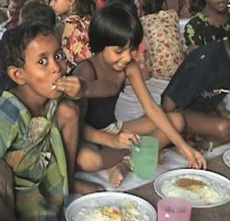India has a third of the world’s poor: World Bank
18 Apr 2013
India accounts for 400 million of the 1.2 billion people still living in extreme poverty across the world while sub-Saharan Africa accounts for another 400 million poor, according to a World Bank report.
 In fact, India's share of the world's poor has gone up to a third of the total from 22 per cent in 1981 while China's share has declined to 13 per cent from 43 per cent in 1981.
In fact, India's share of the world's poor has gone up to a third of the total from 22 per cent in 1981 while China's share has declined to 13 per cent from 43 per cent in 1981.
The World Bank report, which counts people earning less than $1.25 (around Rs65) a day as poor, said the number of such people has decreased dramatically in the past three decades. From 50 per cent of the population of the developing world in 1981, their numbers have dropped to 21 per cent in 2010, despite a 59 per cent increase in the developing world population, the report notes.
The report, The State of the Poor: Where are the Poor and Where are the Poorest?, based on the data released in the latest World Development Indicators, states that extreme poverty rates have fallen in every developing region between 1981 and 2010.
Both Sub-Saharan Africa (SSA) and Latin America and the Caribbean (LAC) seem to have benefited from poverty reduction in the new millennium.
After steadily increasing from 51 per cent in 1981 to 58 per cent in 1999, the extreme poverty rate fell 10 percentage points in SSA between 1999 and 2010 and is now at 48 per cent - an impressive 17 per cent decline in one decade, the report notes.
Other than India, Sub-Saharan Africa is the only region in the world for which the number of poor individuals has risen steadily and dramatically between 1981 and 2010. There are more than twice as many extremely poor people living in SSA today (414 million) than there were three decades ago (205 million).
As a result, while the extreme poor in SSA represented only 11 per cent of the world's total in 1981, they now account for more than a third of the world's extreme poor.
In LAC, after remaining stable at approximately 12 per cent for the last two decades of the 20th century, extreme poverty was cut in half between 1999 and 2010 and is now at 6 per cent.
The report finds that the average income of the extremely poor in the developing world has been rising and steadily converging to the $1.25 per day poverty line. In 2010, the average income of the extremely poor in the developing world was 87 cents per capita per day, up from 74 cents in 1981 (in 2005 purchasing power parity dollars).
"We have made remarkable progress in reducing the number of people living under $1.25 a day in the developing world, but the fact that there are still 1.2 billion people in extreme poverty is a stain on our collective conscience," said World Bank Group president Jim Yong Kim.
"This figure should serve as a rallying cry to the international community to take the fight against poverty to the next level. Our analysis and our advice can help guide the way toward ending extreme poverty by 2030, by showing where the poor live and where poverty is deepest," he said.
"We have made strides in cutting down poverty, but with nearly one-fifth of the world population still below the poverty line, not enough," said Kaushik Basu, World Bank senior vice president and chief economist.
"Directing investment towards the poor will require coordinated effort by the Bank, our country partners, and the international development community, and will, let's face it, entail sacrifice on the part of those who are fortunate enough to be better off," Basu said.
Globally, as of 2010, the aggregate global extreme poverty gap was $169 billion in 2005 PPP terms, which represents approximately 0.25 per cent of global GDP. This is less than half the gap in 1981 ($362 billion).
According to the World Bank, extreme poverty gap is the conceptual amount of direct additional income an average extremely poor person would need to get to $1.25 per day and is not indicative of the level of assistance required to close the gap.